Messari: Arbitrum Value Analysis
Original: 《Arbitrum Goes Into Arbitration》
Author: Kunal Goel
Compiled by: BlockTurbo
Arbitrum launched the ARB token airdrop in March, receiving enthusiastic feedback from users and supporters. The launch of the token transferred the decentralized control of the protocol to the ArbitrumDAO, governed by token holders.
Since the token launch, the situation has changed dramatically. The first improvement proposal aimed to establish the Arbitrum Foundation and allocate funds to it, but it was rejected by token holders due to transparency and unclear communication issues. However, the proposal was merely an approval of actions already taken, thus failing to address the objections of token holders. Concerned token holders and community members raised questions about the utility of the token and why the ARB token, without cash flow, not being Arbitrum's Gas token, and possibly lacking complete governance control, was worth a valuation of billions of dollars.
Why Token?
The rights and responsibilities of traditional financial asset holders (equity and debt) are largely standardized globally and among issuers. However, cryptocurrencies allow issuers to define unique rights and responsibilities for each token, even permitting varying degrees of value capture between similar protocols. These rights and responsibilities form part of the token economic model and play a role in determining the success of the token and the protocol.
ARB's Token Economic Model
ARB is the governance token of ArbitrumDAO, exercising significant control over the Arbitrum One and Nova networks. According to the protocol documents, the DAO controls the following:
- Chain upgradeability and technical future
- DAO treasury
- Token inflation
- Sequencer profits—i.e., the net difference between fees collected from on-chain operations and L1 fees paid by the Sequencer
- All Arbitrum social media platforms and accounts
While the protocol is still in a growth phase, the protocol and DAO are protected by a security committee composed of elected superusers, who can act quickly through multi-signature to address any potential vulnerabilities or risks. The DAO has the authority to change the composition of the security committee through elections and removals.
The legally registered entity in the Cayman Islands, Arbitrum Foundation, also supports the DAO. It is responsible for signing off-chain agreements, allocating funds for the protocol's growth, and managing social media. The DAO has the authority to change the board managing the Arbitrum Foundation.
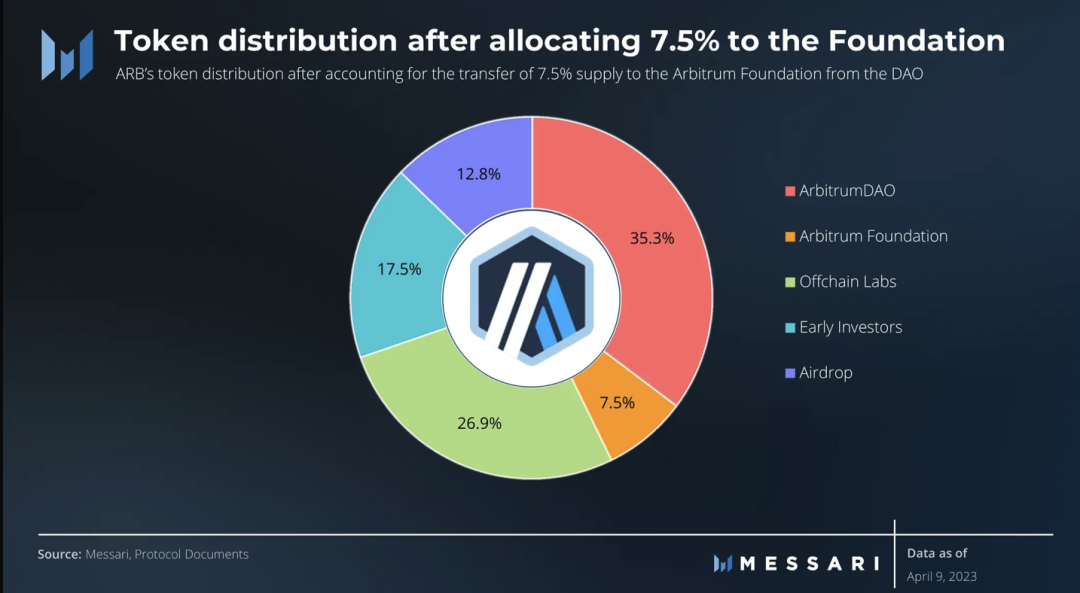
At the time of the token launch, the supply was 10 billion, with a maximum annual inflation rate of 2%. In the initial distribution, 7.5% of the total supply, or 750 million ARB tokens, were transferred from the DAO treasury to the foundation's wallet. The transfer of these 750 million ARB was not disclosed in the initial token distribution. This became a pain point for token holders and was a major reason for the rejection of AIP-1.
Governance Rights
AIP-1 was an approval of actions already taken, raising concerns about whether the ARB token has any governance capabilities. However, the proposal was rejected by token holders, leading to improvements in the transparency and clarity of the protocol's design, which is precisely where the governance capability of the token lies. The foundation has taken various measures to address token holders' concerns, including:
- Publishing transparency reports detailing the foundation's setup and costs;
- Proposing an alternative AIP-1.1 that added a budget and phased unlocking plan for the funds transferred to the foundation;
- Proposing an alternative AIP-1.2 that updated documents to clarify the foundation's role and the DAO's control over it.
Additionally, community member Alex D. proposed AIP-1.05, requesting the foundation to return all funds transferred to it. However, based on the current voting count, this proposal is likely to fail.
Due to direct improvements brought by active governance, concerns about the token's lack of governance capabilities seem to have no practical basis.
Cash Flow
Layer 2 (L2) protocols generate cash flow through two main revenue streams:
- Sequencer profits are the difference between fee income generated from L2 users and expenses paid to the base layer. Arbitrum's sequencer profits will be transferred to the DAO treasury.
- Sequencers can generate maximum extractable value (MEV) by reordering user transaction requests. Currently, Arbitrum sequencer does not capture MEV, but the DAO can profit from MEV by auctioning block production rights once decentralized ordering is implemented. As the main development team of Arbitrum, Offchain Labs is cautious about MEV auctions and is exploring ways to reduce MEV.
Although the protocol currently does not allocate cash flow, these cash flows will accumulate in the treasury and be used for further growth. In modern finance, generating free cash flow and reinvesting it is generally considered a good practice as long as the business is in a high-growth phase. Layer-2 is a high-growth industry, and the cryptocurrency industry is also high-growth. If future growth saturates, the DAO can vote to allocate its free cash flow.
Non-Gas Assets
ARB may never become the Gas token on Arbitrum, but this does not need to be a prerequisite for its value. As it shifts to a decentralized sequencer set, ARB is likely to gain additional utility in the future. The DAO may require sequencers to stake ARB to align incentives economically and allow for slashing in cases of misconduct, similar to validators in proof-of-stake networks. This would increase the token's value as users demand the protocol to provide higher security.
Competition with Optimism
It is clear that the ARB token has value through its cash flow, governance, and security. We can estimate its value by comparing key metrics with its closest competitor, Optimism.
Daily Transaction Volume
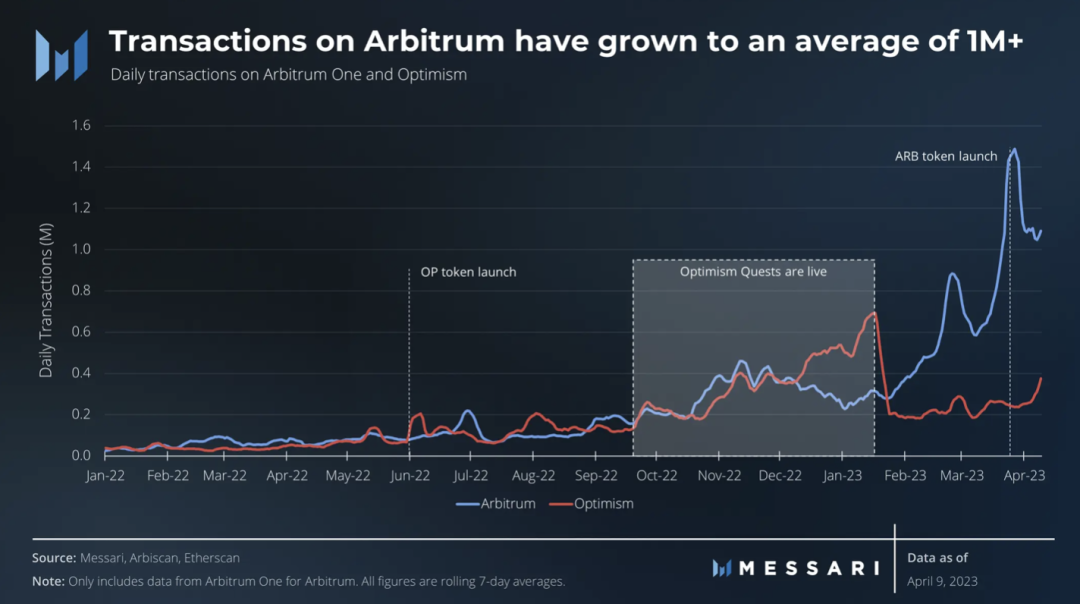
In 2022, Arbitrum and Optimism had similar average daily transaction volumes of 153,000 and 155,000, respectively. However, Optimism's activity seems to have been primarily supported by its incentive program, which ended in January 2023, leading to a sharp decline. In contrast, due to the anticipation of the airdrop, Arbitrum experienced a dramatic increase in 2023, with activity reaching 2.7 million on airdrop day. As of now, Arbitrum's average daily transaction volume is 663,000, more than double that of Optimism, which has an average daily transaction volume of 302,000.
Daily Active Users
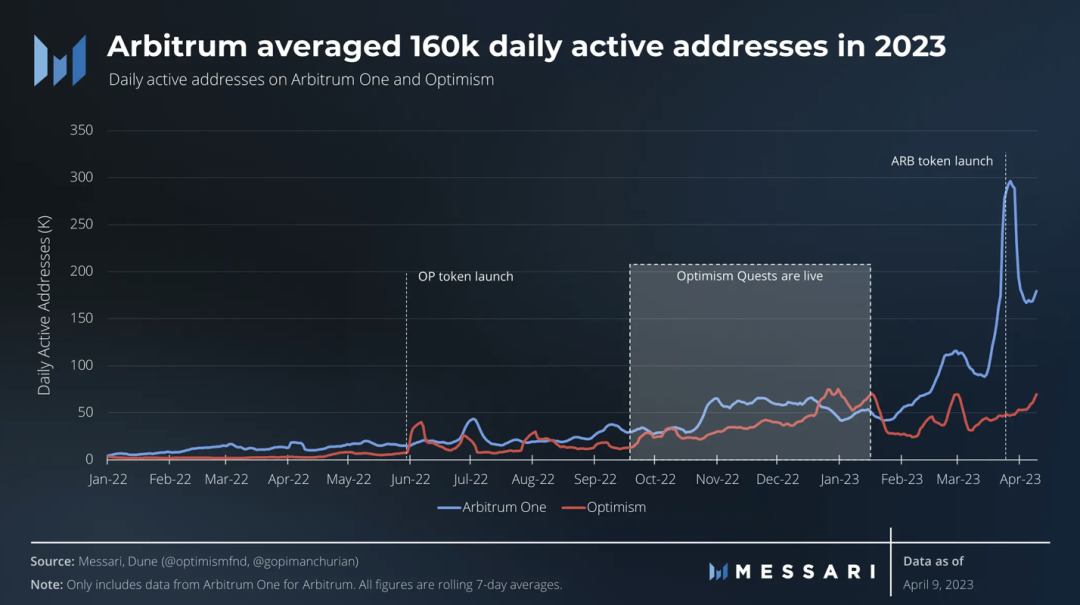
The trend of active addresses mirrors that of transactions, with Arbitrum having more daily active addresses than Optimism. In 2022, Arbitrum had an average of 27,000 daily active addresses, while Optimism had 17,000. As of now, Arbitrum has 164,000 daily active addresses, peaking at 612,000 on airdrop day. Optimism's average daily active addresses in 2023 are 48,000.
Sequencer Revenue and Profits
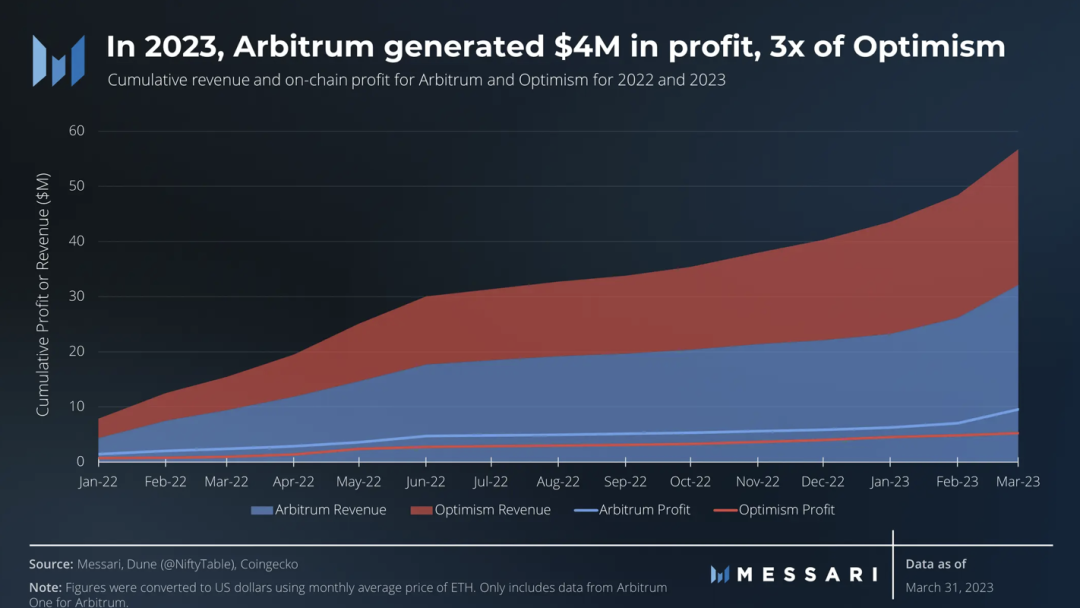
Due to its higher activity, Arbitrum generates more sequencer revenue and profits than Optimism. In 2022, Arbitrum generated $22 million in sequencer revenue and $6 million in profits, while Optimism generated $18 million and $4 million, respectively. In the first quarter of 2023, Arbitrum created $10 million in revenue and $4 million in profits, further surpassing Optimism, which had $6 million in revenue and $1 million in profits.
TVL
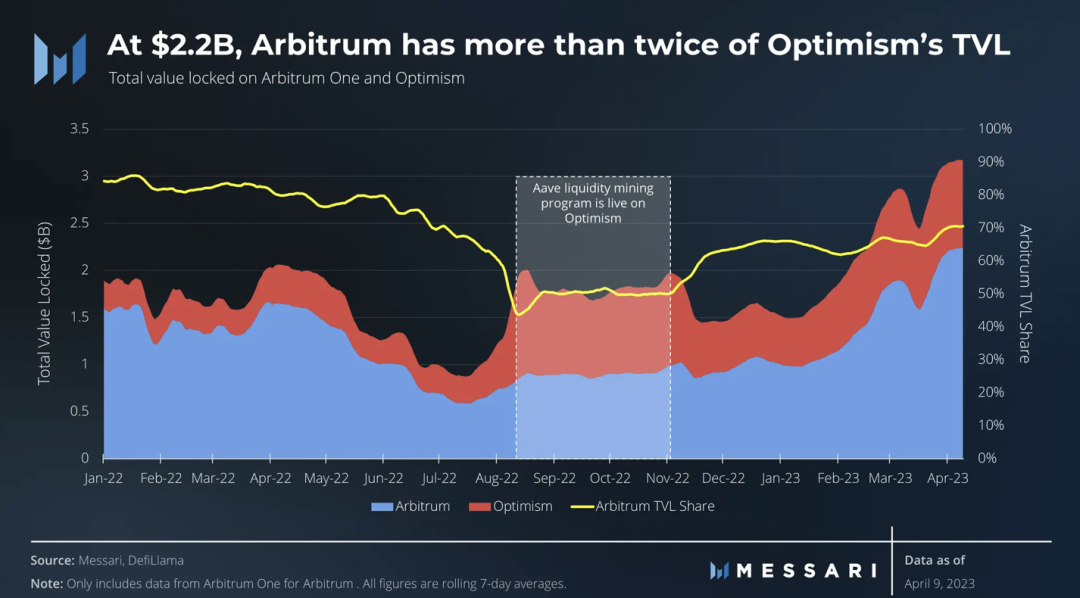
For most of 2022 and 2023, Arbitrum's TVL has been higher than Optimism's. Arbitrum's dominance was further enhanced after the launch of its token, as ARB has become a significant collateral asset in its DeFi protocols. Currently, Arbitrum's TVL is $2.2 billion, while Optimism's is $900 million.
Relative Valuation
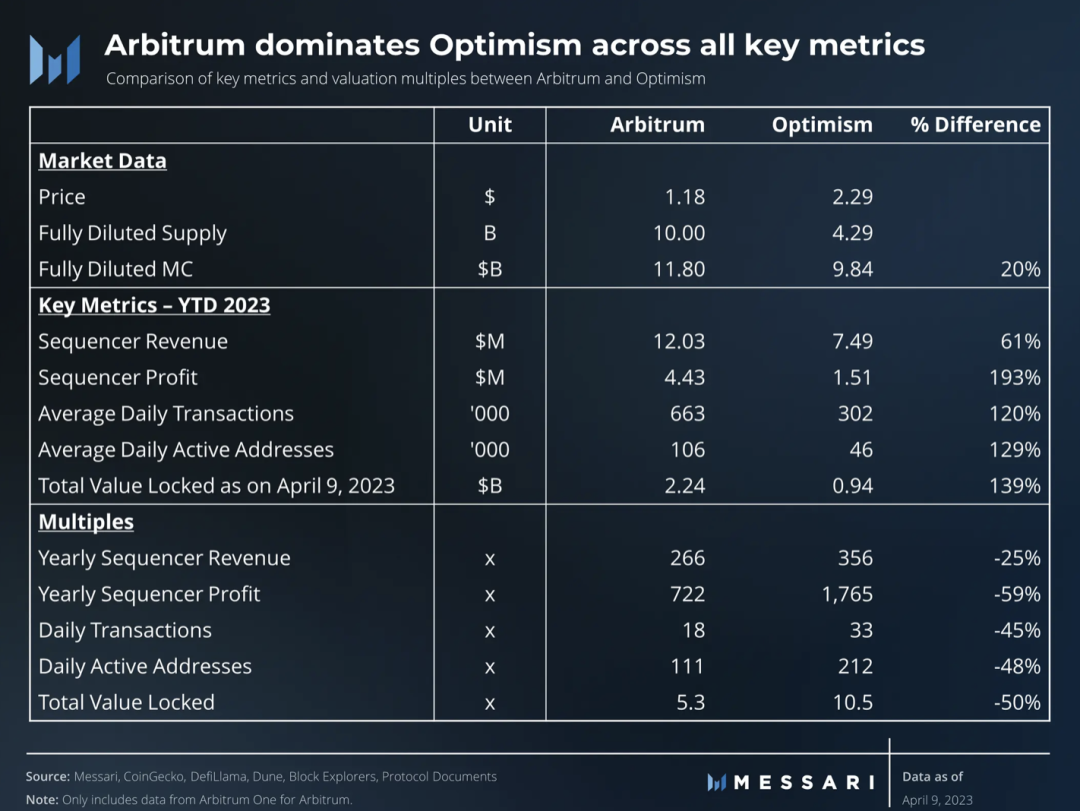
Despite Arbitrum's fully diluted market cap being 20% higher, it is significantly undervalued across all key valuation metrics. Although Optimism has an incentive program, Arbitrum has performed well for most of 2022. Now with the ARB token, Arbitrum can run its own incentive program, further expanding its lead.
Other Factors
While Arbitrum and Optimism are close competitors, the comparison is not entirely accurate. Here are some additional details that should be considered.
Airdrop Activity
Arbitrum experienced a significant increase in activity on airdrop day, including higher transaction volumes, active users, sequencer revenue, and profits. Since the analyzed period is 2023, this somewhat exaggerates Arbitrum's adoption metrics.
Superchain Ecosystem
Optimism is in an early lead in creating a superchain ecosystem, with Coinbase announcing it is building on the OP Stack. Arbitrum has also announced its rollup ecosystem, Arbitrum Orbit, but has yet to announce any significant builders.
Differences in Governance Structure
The ARB token has greater governance control over Arbitrum than OP holders have over Optimism. OP holders share governance with their Citizens' House, which controls revenue generated from sequencers. Therefore, ARB should generate more value from the same revenue than OP.
Conclusion
Arbitrum is the largest Layer-2 solution on Ethereum, leading its only major competitor, Optimism, across all metrics. The DAO and the foundation should ignore this minor trouble and take joint action to ensure Arbitrum establishes its early lead. With the conclusion of the Ethereum Shanghai upgrade, the L2 battle is far from over. Optimism is also planning its own upgrades, and more rollup releases are on the horizon.









